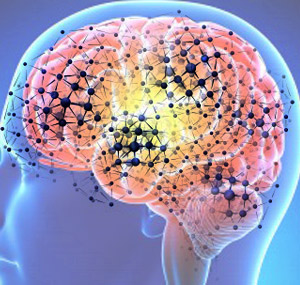Structure
 The human brain, like that of other vertebrates, is divided into three regions: the hindbrain, the midbrain, and the forebrain. These regions plus the spinal cord make up our central nervous system.
The human brain, like that of other vertebrates, is divided into three regions: the hindbrain, the midbrain, and the forebrain. These regions plus the spinal cord make up our central nervous system.
The main structure in the hindbrain is the medulla oblongata, involved with key autonomic functions such as breathing, heart rate, the startle response, alertness, and digestion. The hindbrain also contains nuclei (small brain regions) that receive sensory information from the ear and the organs of balance. On top of the hindbrain is the cerebellum, an important site for integration of sensory and motor input, balance, and coordination of the multiple steps required in complex voluntary movements. The pons conveys movement information from the cerebral cortex to the cerebellum.
The main structure in the midbrain is the optic tectum. This structure receives visual input along with that of other senses, including sound, and controls eye movement. The tectum spatially aligns different sensory input to create a single map of the animal’s world around it, enabling us and other animals to precisely visually orient and react to a particular sound or movement.
The forebrain includes the cerebral cortex and diencephalon, the latter of which contains two structures: the thalamus and the hypothalamus. Thalamic nuclei act to relay and process information between the cerebral cortex and the rest of the brain. The hypothalamus regulates endocrine (hormonal) and autonomic responses.
Each side, or hemisphere of the cerebral cortex is comprised of four lobes: the occipital lobe, the temporal lobe, the parietal lobe, and the frontal lobe, and three deeper structures; the basal ganglia, hippocampus, and amygdala. The basal ganglia help coordinate and integrate movement; the hippocampus helps in the acquisition of memory, and the amygdala helps make sense of social information, integrating sensory information with endocrine and autonomic information.
The occipital lobes (in the very back of our heads) receives visual input from the eyes and processes the images through multiple maps of the visual world to enable visual perception. One can think of a visual map as what a camera would see through a particular filter. The different maps ‘see’ with different filters. Each map serves a different processing function, helping the brain to make sense of color, lines, motion, patterns, faces, and words, among others. The more visual an animal is, the more maps it requires in its brain to help make sense of its visual world.
The parietal lobes are the site where touch information (somatosensory information) is processed. Here, the brain contains multiple somatosensory maps of our entire bodies to process different touch information, such as deep or light touch. These lobes are also the site for visual attention. Unless we are attending to a visual object in our world, we might not be aware of it.
The temporal lobes are the site for processing sound in auditory maps, categorizing objects, the initial laying down, or consolidation, of memories, emotions, some higher-order visual processing, and language.
The frontal lobes are the site of our motor cortex, which guides voluntary movement. The frontal lobes and its subregion, the prefrontal cortex, are key structures for complex thought. They play a role in judgment of the consequences of our actions, goal-setting, control of emotional responses, including the inhibition of socially inappropriate behaviors, and memory for habits and complex motor patterns. This region is considered the site of the brain’s executive function.

